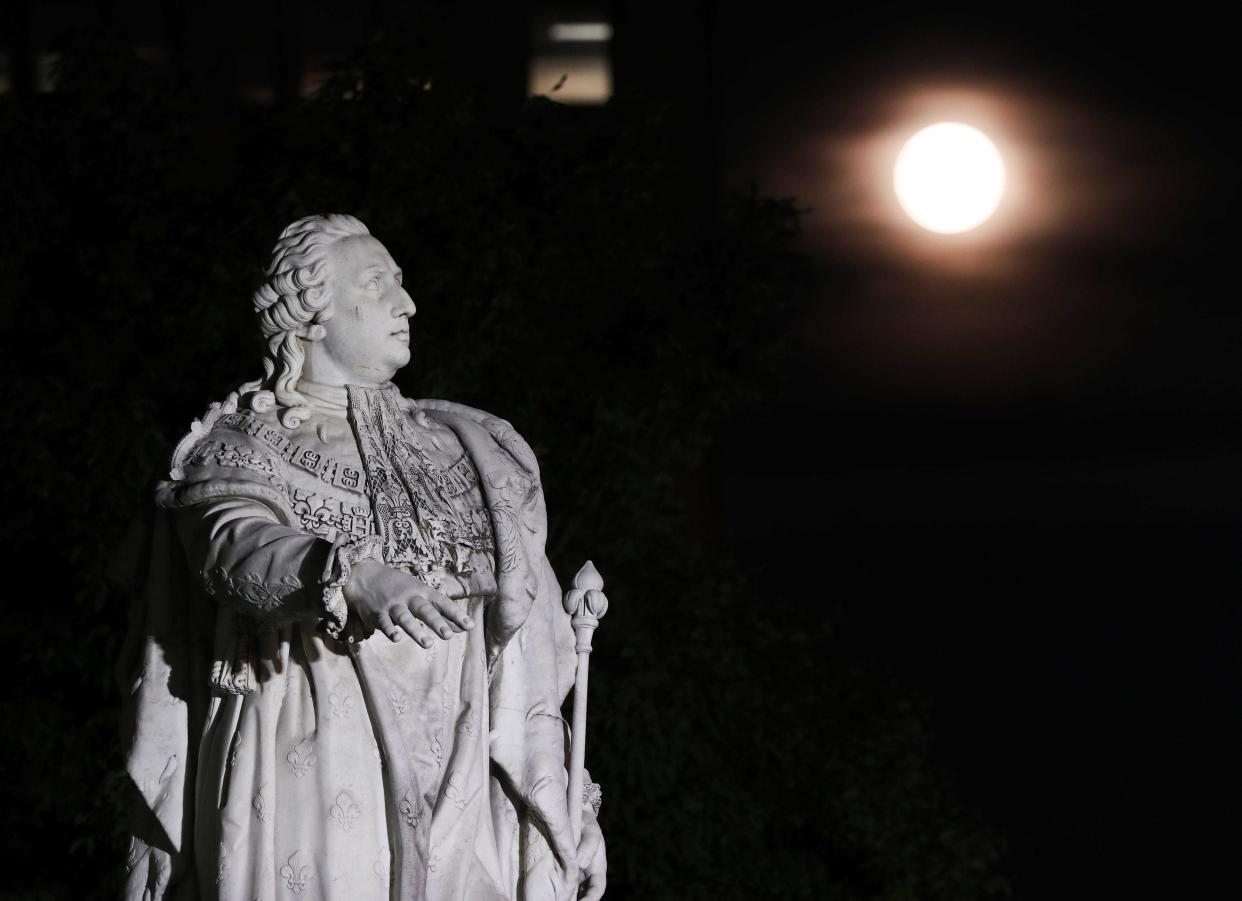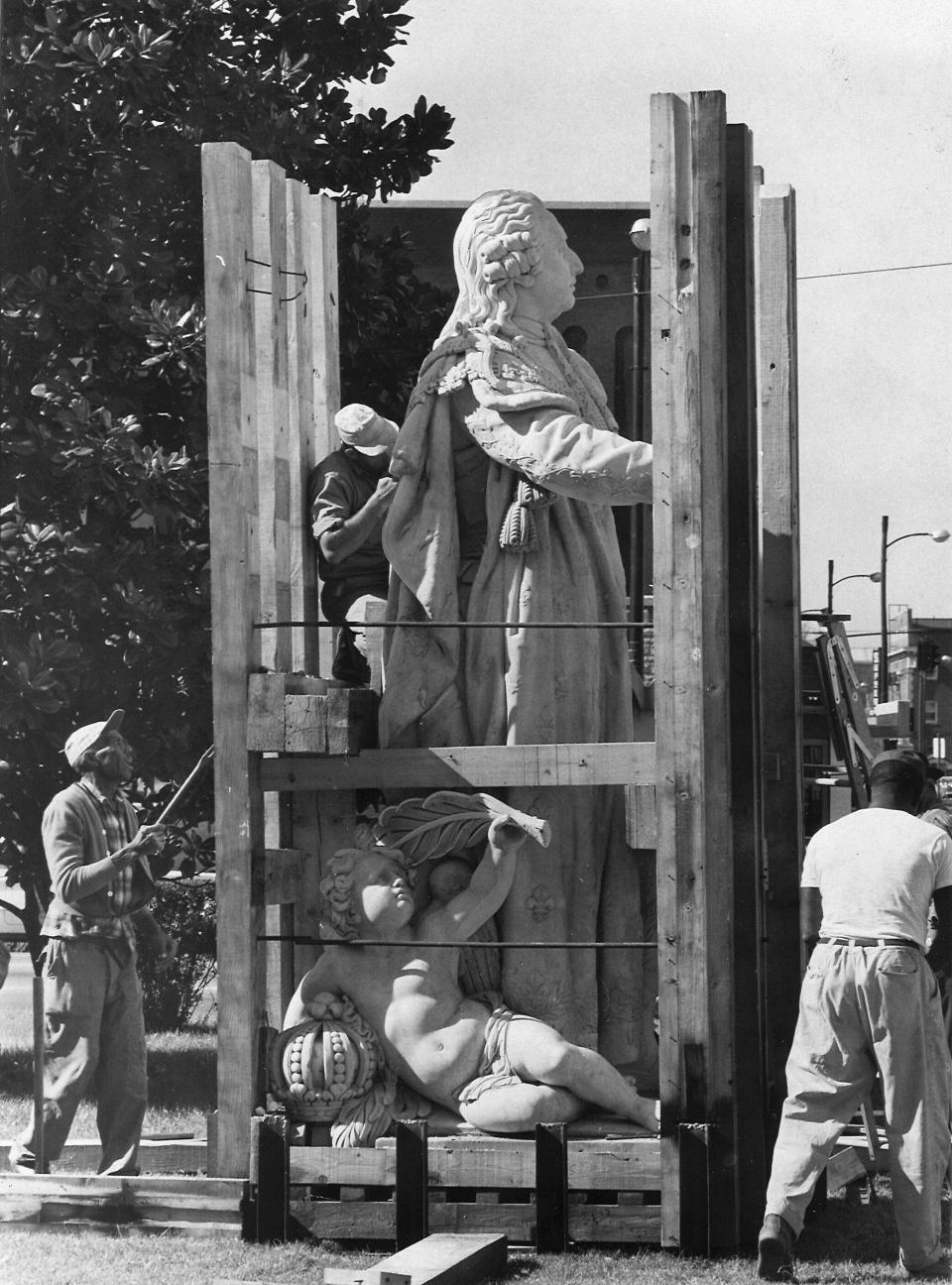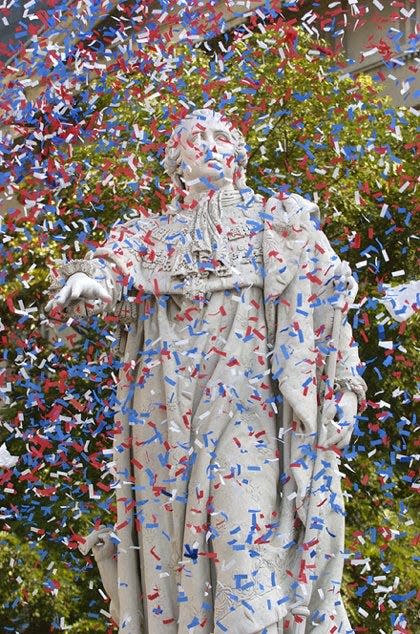Retro Louisville: King Louis XVI statue

- Oops!Something went wrong.Please try again later.
“Louisville will get a statue of King Louis XVI from her sister city, Montpellier, France, if arrangements for transportation can be worked out. A representative of the Montpellier mayor discussed the gift offer with Mayor Kenneth A. Schmied yesterday. The statue of Louisville's namesake was intended as a 'gesture of friendship' and assurance that the friendship 'is forever.'
“The statue is now in (storage). Montpellier offered to pay for land transportation of the statue if Louisville would arrange for water transportation. (It was) suggested that the Navy might provide transportation across the Atlantic. Louisville took its name in recognition of the assistance given the American colonies by King Louis XIV during the Revolutionary War. Louisville and Montpellier have been sister cities (since 1954).”
This brief article in the Aug. 2, 1966, edition of the Courier Journal announced this extraordinary art gift to Louisville.

Three months later, Nov. 6, 1966, the sculpture was transported by a Navy ship to Norfolk, Virginia, where it would then be carried by freight train to Louisville. However, no location had been identified to install it. “Mayor (Kenneth) Schmied said that the statue should be placed ‘in a focal spot where people can walk by and see it.’”
Courier Journal writer Sarah Lansdell gave the statue a royal tribute with a three-page history in the April 30, 1967, Sunday magazine. Lansdell detailed how King Louis XVI was still unpopular, but there was disagreement in France over whether to keep the sculpture hidden or give it away to be displayed.
Once the political debate was resolved to the benefit of Louisville, the question remained where to place the statue.
The J. B. Speed Art Museum was the logical site, but “Charles Riehm, president of a monument company, pointed out that, without reinforcement, the statue would go through the museum floor. ‘So why not outside?’”
Riehm said “the statue weighs about 18,000 pounds (9 tons)" and “the statue was an ‘outdoor’ type of Carrara marble, which can take the weather with proper care.”
Marie-Therese-Charlotte, the King’s daughter who survived the French Revolution, commissioned Achille-Joseph Valois to create this sculpture of her father. This statue, therefore, has a direct family connection to Louisville’s namesake.
The statue originally was placed on a Montpellier public square in 1829 but by 1848, due to more French political upheaval, the statue was stored for the next 118 years.

Lansdell noted that “Louis was guillotined at the hands of revolutionaries inspired by the example of the United States, which (ironically) Louis himself had helped to win independence by sending Lafayette, money and troops. Louisvillians have flown the fleur-de-lis for years”, which is a symbol of the French monarchy.
“It would be an ironic twist to history to set Louis up in sight of his illustrious contemporary Thomas Jefferson, whose statue stands at the Courthouse. Jefferson spent six years at Louis’ court as U. S. Minister to France” Landsdell wrote suggesting that the statue should be placed near the Courthouse (now called Metro Hall).
By June 7, 1967, with the headline “Meandering Monarch’s Travels to End," Courier Journal reporter Ken Loomis stated the statue will be placed “on the west side of the Courthouse, from which point the statue will gaze unendingly at the Sixth Street entrance to City Hall.”
“The strings snapped as Mayor Francois Delmas of Montpellier, France, unveiled the statue of King Louis XVI yesterday (July 17, 1967) morning.” Delmas said: “Let this statue say ‘No, the French have not changed. The French have not forgotten the Hills of Artois nor the Normandy beaches’ “ the Courier Journal in its July 18, 1967, edition reported.
Schmied added: "The statue is by any standards a rare art treasure, and will be immeasurably enjoyed by the people of Louisville, apart from its historical significance."
Charles Lucet, French Ambassador to the United States, who also attended, said: “Now the statue of the king, who was your friend, is going to stand on Jefferson County Courthouse grounds, and the name of Jefferson lends itself happily to the evocation of these souvenirs of the French-American relationship.”
Since its unveiling, the King has suffered several injuries. His right hand and left foot have "come off" over the years. And the statue made the front page of the Feb. 3, 1991, Courier Journal when repair costs were upwards of $20,000.
Following vandalism during the May 2020 protests, it was removed to a city storage facility that September. Restoration costs were estimated at around $200,000.
Thus, for its 195 years of existence, the statue has been publicly displayed for just 72 years.
This statue is also the linguistic pronunciation of "Louisville." Depending on how you pronounce King Louis, it is either Looavul, Luhvul, Looaville, or some other dialect of your choosing.
As to the statue’s future, Metro Council included restoration funds in its draft budget for the upcoming year.
Hopefully, it will be reinstalled before the statue’s bi-centennial in 2029 so that it can be again displayed as a "gesture of friendship" that will last "forever."
Steve Wiser, FAIA, is a local historian, author, and architect
This article originally appeared on Louisville Courier Journal: What happened to Louisville's King Louis XVI statue?

